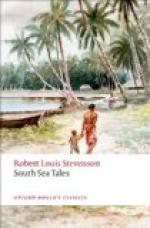Now for the Samoan story. I owe it to the kindness of Dr. F. Otto Sierich, whose collection of folk-tales I expect with a high degree of interest. A man in Manu’a was married to two wives and had no issue. He went to Savaii, married there a third, and was more fortunate. When his wife was near her time he remembered he was in a strange island, like a poor man; and when his child was born he must be shamed for lack of gifts. It was in vain his wife dissuaded him. He returned to his father in Manu’a seeking help; and with what he could get he set off in the night to re-embark. Now his wives heard of his coming; they were incensed that he did not stay to visit them; and on the beach, by his canoe, intercepted and slew him. Now the third wife lay asleep in Savaii;—her babe was born and slept by her side; and she was awakened by the spirit of her husband. ‘Get up,’ he said, ’my father is sick in Manu’a and we must go to visit him.’ ‘It is well,’ said she; ’take you the child, while I carry its mats.’ ‘I cannot carry the child,’ said the spirit; ‘I am too cold from the sea.’ When they were got on board the canoe the wife smelt carrion. ‘How is this?’ she said. ‘What have you in the canoe that I should smell carrion?’ ‘It is nothing in the canoe,’ said the spirit. ’It is the land-wind blowing down the mountains, where some beast lies dead.’ It appears it was still night when they reached Manu’a—the swiftest passage on record—and as they entered the reef the bale-fires burned in the village. Again she asked him to carry the child; but now he need no more dissemble. ‘I cannot carry your child,’ said he, ’for I am dead, and the fires you see are burning for my funeral.’
The curious may learn in Dr. Sierich’s book the unexpected sequel of the tale. Here is enough for my purpose. Though the man was but new dead, the ghost was already putrefied, as though putrefaction were the mark and of the essence of a spirit. The vigil on the Paumotuan grave does not extend beyond two weeks, and they told me this period was thought to coincide with that of the resolution of the body. The ghost always marked with decay—the danger seemingly ending with the process of dissolution—here is tempting matter for the theorist. But it will not do. The lady of the flowers had been long dead, and her spirit was still supposed to bear the brand of perishability. The Resident had been more than a fortnight buried, and his vampire was still supposed to go the rounds.
Of the lost state of the dead, from the lurid Mangaian legend, in which infernal deities hocus and destroy the souls of all, to the various submarine and aerial limbos where the dead feast, float idle, or resume the occupations of their life on earth, it would be wearisome to tell. One story I give, for it is singular in itself, is well-known in Tahiti, and has this of interest, that it is post-Christian, dating indeed from but a few years back. A princess




